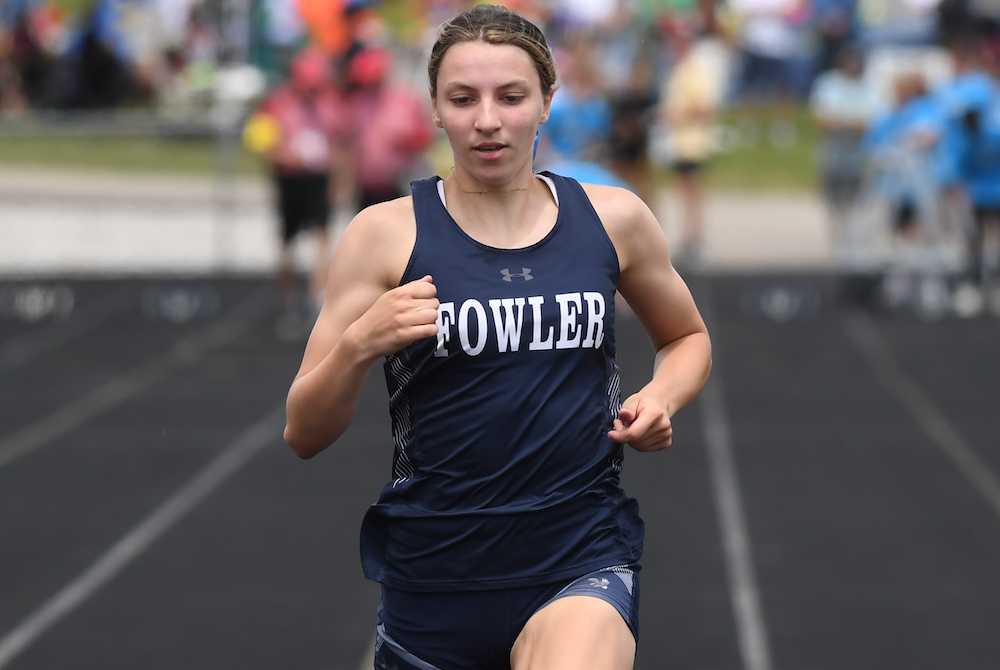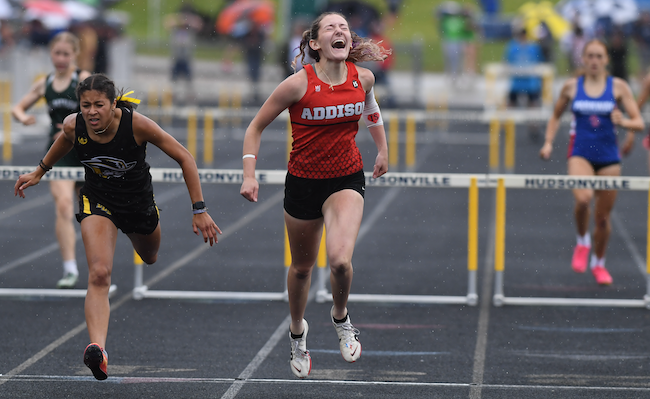
Track Gaining Speed Toward Future with Electronic Starting Devices
By
Steve Vedder
Special for MHSAA.com
May 23, 2023
Aubrey Greenfield thinks it might be the perfect time to reevaluate 130 years of tradition.
For a number of reasons, from technical to personal, the Oxford senior sprinter believes it makes sense for the crack of a starting pistol to be eliminated from high school track meets.
Because track meets would benefit in various ways from lowering costs to easier setup at meets to the human factor of competitors not having to flinch at the crack of a pistol shot, Greenfield believes the sport has a chance to embrace new technology – electronic starting devices (ESD).
In essence, an ESD replaces the starting pistol with a light flash, tone sound or both to begin a race.
"High school sports should put the athlete first," Greenfield said. "We should promote sports, and eliminating starting pistols promotes health in terms of PTSD or trauma for athletes and spectators and that would be good. I would like to think people would say that's a good idea."
In fact, Greenfield would go as far as to say if there was not an implementation of electronic starting devices, many of her teammates would have considered giving up the sport.
"If it's something that helps us compete safely, we're all for it," she said.
Greenfield's opinion apparently is spreading. Michigan High School Athletic Association senior assistant director Cody Inglis said the use of ESD makes it both affordable for meet starters and sensible for athletes and fans to rethink the use of starting pistols. While the MHSAA is not mandating electronic starting devices, it does promote the use of what Inglis calls "emerging technology." He notes that ESD are becoming the norm for organizations such as USA Track & Field, the NCAA and an increasing number of high schools.
 "I think we have to embrace new technology, and we think this will be something that takes hold," Inglis said.
"I think we have to embrace new technology, and we think this will be something that takes hold," Inglis said.
A key part of embracing ESD is the human element. The tragic Oxford High School shooting Nov. 30, 2021, that took the lives of four students while injuring seven others should not be relived even for a fleeting instance at a high school sporting event. Oxford athletic director Tony DeMare said the school began using ESD at every meet, including the MHSAA Lower Peninsula Division 1 Finals last June. He said that decision was embraced by virtually all schools Oxford encountered.
"We were very convinced that the alternative (of ESD) would promote a healthy attitude," DeMare said. "We were overwhelmed with the positive response. If a school was on the fence about it or might not be for it, I think we've started to see the tide turn in favor of people willing to listen and learn about electronic starting devices."
Inglis said the MHSAA is acutely aware of what the crack of a starting pistol can mean to athletes and fans.
"It's unimaginable what Oxford went through, and this is a small way we can help," he said. "We look at a (starting pistol) and think, ‘Could we do something else?’ It's a way of helping to solve a problem."
Over the last several years, the MHSAA has embraced finding an alternative to starting pistols. Inglis noted the discussion started with the cost and diminishing availability of 32-caliber ammunition that meet starters use. A box of ammunition, if it can be found, is around $75 a box.
In addition to cost, there is potential damage from excessive exposure to 150-plus decibels of sound generated by the traditional 32-caliber blanks. Medical studies show damage to ears caused by decibel levels above 120 dB.
The tragedy at Oxford accelerated the conversation.
Inglis said the cost of ESD can be likened to a school sinking money into artificial surfaces at football fields. Yes, there is a great cost at first, but over time money is ultimately saved. An ESD system itself ranges between $200 and $500. Speakers also may need to be purchased, but with ESD starting events like the 800 and 1,600-meter relays positioned near the outside lanes 8, 7, 6 and 5 would result in improved hearing by athletes at the start of a race.
There is one challenge with ESD that track administrators are working to overcome – lighting conditions that lessen the ability to see the ESD’s LED light or strobe when the button is pressed by a starter to begin a race. But that vision difficulty resulting from clear blue skies and backgrounds of setting suns can be substantially improved by incorporating a black background with an ESD – something as simple as a starter holding up black cardboard behind the lighting mechanism at the start of an event.
Inglis said when all factors are considered, the use of ESD makes sense.
 "With the climate we live in nowadays, no lookalike guns is good," he said. "We're not mandating this. But people are saying this is affordable."
"With the climate we live in nowadays, no lookalike guns is good," he said. "We're not mandating this. But people are saying this is affordable."
While switching to ESD would break 130 years of tradition, the timing could be a step forward, said Jeff Hollobaugh, co-author of the book "The Fleet Feet of Spring: Michigan's High School State Championships in Track & Field." He said while no definitive answer is possible, it's likely starting pistols were used at the inaugural state meet at the Jackson Fairgounds in 1895. The meet, which included events like tossing a 16-pound shot put, bike races and a 100-meter sprint, was sponsored by the Michigan Interscholastic Athletic Association (a predecessor to the MHSAA) and comprised mostly of the state's larger schools.
Hollobaugh's sentiments echo what many involved in today's high school track & field believe in terms of making a transition from starting pistols to electronic starting devices.
"It's a change, not necessarily good or bad, just different," he said. "It's not a drastic change, but it will take some getting used to. But it is the future. In the end, we'll all be fine."
DeMare believes the future of high school track will definitely include ESD.
"Our desire is that the practicality and sensibility of this will overcome the alternative," he said. "I think we'll see the automation and electronics taking hold of certain elements in track, and people will embrace it."
PHOTOS (Top) Runners watch official Bertha Smiley as they prepare to begin a race during last season's Lower Peninsula Division 1 Finals at Rockford. (Middle) An electronic starting device provided by VS Athletics was used to start those races. (Below) Smiley sets to begin an event. (Photos provided by David Kuderka/VS Athletics.)

Fowler Girls Award 1st-Year Coach with Program's 1st Finals Title since 2019
By
Keith Dunlap
Special for MHSAA.com
June 2, 2024
HUDSONVILLE — Sometimes it actually isn’t so hard to replace a legend. Just ask Fowler girls track & field coach Neil Hufnagel.
After last year, Hufnagel took over for longtime Fowler coach Jill Feldpausch, who built the program into a dynasty.
Feldpausch led Fowler to five MHSAA Finals titles from 2011 to 2019, but there was no need for anyone to feel sorry for Hufnagel going into this year.
On the contrary, it might have been the track & field version of inheriting a Fort Knox-sized gold mine.
“She left the cupboards absolutely packed,” he said.
That was evident during the Lower Peninsula Division 4 Finals on Saturday at Baldwin Middle School, where Fowler reigned supreme again with a dominant performance.
Fowler finished with 70.5 points, well ahead of the 44 collected by runner-up Portland St. Patrick.
Fowler had only one first-place event finish, and that was in the last one, taking first in the 1,600 relay in a time of 4:08.44.
But that didn’t end up mattering as Fowler used its depth to score points.
The Eagles, who finished fourth last year, snapped a mini drought by their standards.
“We talked a little bit about being workmanlike,” Hufnagel said. “We know that it doesn’t take first places to finish first in the state. We had some good team depth, and we were able to use that.”
 Saugatuck was third with 34 points.
Saugatuck was third with 34 points.
There were several individual standouts who flanked Fowler’s team victory.
Buckley senior Aiden Harrand, who will run next for Wake Forest, won the 1,600 in a time of 4:53.25 and the 400 in a time of 58.25. Harrand also finished second in the 800.
Between cross country and track, Harrand finished her high school career with 10 Finals championships and showed impressive versatility.
“It’s hard for sure,” Harrand said. “I do a lot of distance training. I have to because I have to be prepared for that mile. I think the speed comes naturally. I do a lot of speed workouts and stuff. But you’ve got to train distance.”
Another individual standout was Addison junior Molly Brown. She repeated in the 100 hurdles in a time of 15.22, and then won the 300 hurdles in a time of 45.07.
Brown was second in the 300 hurdles last year, and she obviously was thrilled to build on that defeat and set up what should be a big senior year in 2025.
“I knew the girl that beat me last year graduated, but I knew that coming in this year, I was going to have to run a really good time to win,” Brown said. “I just really wanted to win.”
In the field events, Marlette senior Olivia Findlay shined the brightest, winning the long jump with a distance of 17-feet, 4½ inches and the high jump in 5 feet, 5 inches.
Other champions included Unionville-Sebewaing sophomore Layla Bolzman in the 100 and 200, Johannesburg-Lewiston junior Allie Nowak in the 800, Whitmore Lake freshman Kaylie Livingston in the 3,200, Chesterfield Austin Catholic senior Lyla Mullins in the shot put and discus and Mason County Eastern junior Payton Haynes in the pole vault. Frankfort (400), Portland St. Patrick (800) and Whitmore Lake (3,200) also won relays. Athens junior Aleyah Deller won the adaptive 100, 200 and shot put events.
PHOTOS (Top) Fowler's Katie Spicer crosses the finish line during a sprint Saturday. (Middle) Addison's Molly Brown, right, finishes her 100 hurdles championship win. (Click for more from Ken Swart/RunMichigan.com.)

